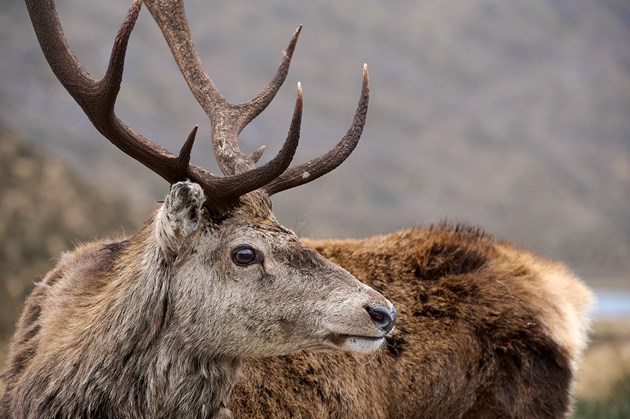01 November, 2024
Deer awareness campaign targets high-risk stretch of A9

A high-risk location on the A9 for collisions between deer and vehicles is the focus of a new autumn road safety campaign launched today.
Drivers will be warned to slow down and look out for deer along a 500m stretch of road immediately north of the Navidale roundabout, near Helmsdale.
NatureScot is working with Transport Scotland and BEAR Scotland to display warning messages on mobile electronic signs at the location. The campaign will run for three weeks from November 1 to November 22.
This year, the campaign will also include monitoring traffic speed to see the extent to which the signs are influencing driver behaviour.
Navidale is the only Highland location in the list of top 10 sites in Scotland with the highest number of recorded deer-vehicle collisions. The other high-risk locations are all found in the Central Belt and are linked to the dispersal of young roe deer in the spring.
In contrast, the species of most concern at Navidale is red deer as they move from higher moorland to better pasture at lower altitudes in autumn. Red deer stags in particular may be tempted to richer feeding grounds to recover following their rutting activity.
Analysis for NatureScot shows that ten deer-vehicle collisions have been recorded along the stretch of road in recent years.
Dominic Sargent, NatureScot Deer Policy Officer, said: “As part of our work to reduce deer impacts across Scotland, we’re exploring a range of options to help tackle the complex problem of deer-vehicle collisions. The records we have indicate that the Navidale area is a clear priority for public safety and that’s why we’re focusing our autumn campaign here for a second year.
“These warning messages are an important reminder to drivers to be ‘deer aware’ along this high-risk stretch. Simply slowing down and being alert to the possibility of deer can really help to reduce the likelihood of collisions.
“While it can be difficult to assess the impact of mitigation, as there is inevitably a natural variation in the number of incidents between years, and some will also go unreported, introducing speed monitoring will give us a helpful indication of the extent to which driver behaviour is being influenced.”
Angus Corby, Transport Scotland Landscape and Biodiversity Manager, said: “We continue to work closely with colleagues in NatureScot and our Operating Company contractors to assess the extent and impact of deer-vehicle collisions across Scotland’s trunk roads, and to determine where mitigation is most needed. This work is a vital part of the overall management of the Network for the reliability of these strategic transport routes and the safety of those using them. It is also important for the welfare of the wild deer which are an intrinsic part of the landscape.
“The proposals at A9 Navidale have been designed to remind drivers of the potential risks of deer crossing the road at this time of year, but will also provide valuable information about the impact of the mobile warning signs, helping to refine the options available to reduce future occurrences.”
ENDS
Contact information
- Name
- NatureScot Media
- Telephone
- 0131 316 2655
- media@nature.scot
Notes to editors
Tips for driving safely:
- Particularly in peak times, slow down and watch for deer crossing roads. Be aware that if along wooded or heavily vegetated verges, deer can suddenly appear before you have time to brake.
- Try not to swerve to avoid hitting a deer. A loss of vehicle control or a collision into oncoming traffic could be even worse.
- Only brake sharply and stop if there is no danger of being hit by following traffic. Try to come to a stop as far away from the animals as possible to allow them to leave the roadside without panic and use your hazard warning lights.
- After dark, use full-beams when there is no oncoming traffic, as this will illuminate the eyes of deer on or near a roadway and give you more time to react. But dim your headlights when you see a deer or other animal on the road so you don’t startle it.
- Report any deer-vehicle collisions to the police, who will contact the local person who can best help with an injured deer at the roadside. Even if you’re uninjured and your car isn’t damaged, the deer may be fatally injured and suffering. Do not approach an injured deer yourself – it may be dangerous.
NatureScot is Scotland's nature agency. We work to enhance our natural environment in Scotland and inspire everyone to care more about it. Our priority is a nature-rich future for Scotland and an effective response to the climate emergency. For more information, visit our website at www.nature.scot or follow us on X at https://x.com/NatureScot
’S e NatureScot buidheann nàdair na h-Alba. Bidh sinn a’ neartachadh àrainneachd na h-Alba agus a’ brosnachadh dhaoine gu barrachd suim a chur ann an nàdar. Tha e mar phrìomhachas againn gum bi nàdar na h-Alba beairteach agus gun dèilig sinn gu h-èifeachdach le èiginn na gnàth-shìde. Tha an tuilleadh fiosrachaidh aig www.nature.scot no air X aig https://x.com/NatureScot

